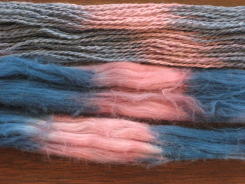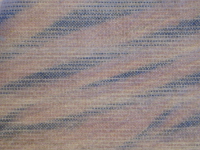One of the many beauties of this pre-treated cotton is that you can use natural dyes without the time consuming preparatory steps of scouring and mordanting.
While there is no objection to slow cloth, the reduction of both chemicals and prep time is of great benefit if you teach and are introducing natural dyes. The safety aspects of chemical reduction are especially important if you teach children.
The treated cotton has an affinity to all dyes. Certainly it can be mordanted--if you are already a natural dyer you know that some mordants shift some colors. You can use this to your advantage. Also, the current state of the art for high quality ring spun yarns limits the percentage of treated cotton to 50%. So half of the yarn is treated and half is not. For this reason you will get a dark charcoal, not black.
The quick rundown on using the Dye-Lishus® cotton with natural dyes is not intended to be a a class in dyeing with natural dyes. Take some workshops, read some books. My personal library is on Library Thing, and the natural dye books are tagged with my favorite reference books rated 4 and 5 stars. Click here to see my list, and then click on the Rating heading to sort my favorites.
Starting out dyeing without mordants, wash your yarn or fabric well. Hot water is preferred. You may dry and put aside for later or dye immediately; your goods should be wet before entering into a dye bath.
Prepare your dye bath. Some options are:
- Use flowers, leaves, roots, or bark and steep in hot water until the bath has good color. It is best not to boil yellows unless you want gold. Flowers could include marigolds and goldenrod, leaves could include weld and rhododendron, roots could include madder and dock, and bark could include hemlock and black oak. Grow your own dye garden or forage legally and safely.
- Berries give blues and purples, but are what I call "Cinderella colors", because they are stains, not dyes. They not only fade, they change color to pale tan or beige. Attempts to dip again in berry colors have no effect.
- Use powdered extracts. These are easily purchased online, but you will need to use a mask. Avoid them if you have respiratory problems. You don't want to expose children to the dust.
- Use concentrated liquid extracts. These are available from Botanical Colors along with a wealth of information on dyeing.
Dyes attach to fibers at different rates. this is called "strike", and some dyes react very rapidly and some more slowly. If you want to get even dye coverage, dyes that strike fast should be used in warm rather than hot water. All dyes can be used cold, the time it takes for the goods to accept color will range from 15 minutes to overnight, depending on the dye/fiber reaction time.
Now--if you are a natural dyer, go ahead and scour your fabric first, then you have options:
- Mordant and dye, using much less dye than normal. Expect the treated cotton to be a darker color.
- Dye without a mordant, then mordant and dye again in a different color to get a visual color blend
- Do the above sequence with shibori techniques before or after mordanting
- Play with the order of dyeing substantive and other dyes
Do note that substantive dyes, dyes that do not require a mordant, will dye both the treated and untreated portions of yarn and fabric. These dyes include turmeric, saffron, safflower, black walnut, and annatto. Indigo, a vat dye, will also dye both.
Below are some samples of Dye-Lishus® cotton fiber, yarn, and fabric dyed with natural dyes without a mordant.
|
Fiber: Natural Dyes: Cochineal, Lac, Red Sandalwood, Osage Orange, Logwood, Black Walnut 100% Dye-Lishus® cotton sliver, dyed with natural dyes. |
 |
|
Fiber: Natural Dyes: Auarelle Liquid Saxon Blue and Lac I haven't gotten around to spinning and weaving it yet, but here are Aquarelle liquid natural dyes lac (pink) and Saxon blue on the Dye-Lishus® cotton sliver and yarn. The sliver is 100% Dye-Lishus® cotton, and the yarn is 50%. You can tell the difference in the way the 50% and 100% fibers take up the dyes. |
 |
|
Yarn: 2 or 4 shaft Plain Weave, dyed after weaving. Natural Dyes: left to right Saxon blue, Himalayan rhubarb, lac, undyed Something very simple: put on a multi-colored warp, weave with the Dye-Lishus® cotton, then dye the fabric any color you want. Warp: 20/2 cotton,multiple colors |
 |
| Yarn: 16 shaft Lace Scarves, dyed after weaving. (download wif file)
Natural Dyes: cochineal, lac, himalayan rhubarb, osage orange. I wanted to put a simple color stripe in these lacy summer scarves. |
 |
|
Yarn: 16 shaft Little Windows napkins, dyed after weaving (download wif file) All samples were woven on the same warp and dyed after weaving. Natural Dyes: left to right: Aquarelle Saxon Blue, Dylon Violet, Aquarelle Saxon Blue, Onion skins Warp: 10/2 Dye-Lishus® blend cotton |
|
|
Fabric: Mock ikat Natural Dyes: Aquarelle liquid Natural Saxon Blue and lac Arashi shibori on one of the striped fabrics |
 |
|
Fabric: Sew and then dye Natural Dyes: 3 successive baths. First weld (yellow), then Saxon Blue, then scrumbled and dipped in vatted indigo. Th first two dips dyed only the stripes. Vest made with striped fabrics. |
 |

